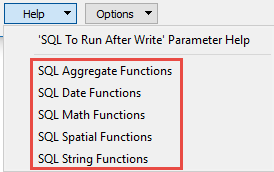| Database Connections |
|---|
|
Connections store authentication information. For general information about sharing database connections, please see Using Database Connections. Note: Depending on context and/or database format, you might see different combinations of Database Connection parameters. Select an existing connection, or Add Database Connection to define a new connection. The new connection can be made visible only to the current user, or can be shared among multiple users. |
Connection Parameters
The IP/host of the LDAP server.
The port of the LDAP server.
Whether or not to use TLS/SSL connections over LDAP.
Enter the username and password to access the database, user account, or wherever authentication is required.
The time, in seconds, after which to terminate a query to the database if it has not yet returned a result.
If set to 0, there is no timeout. The default is 30.
Note: If this value is not set high enough, then the query will return the error Provider Error - Timeout Expired.
- Object Only: Read attributes of specified object(s).
- Immediate Children Only: Read attributes of immediate children of specified object(s).
- Object and All Children: Read attributes of specified object(s) and children at any depth.
Constraints
After you have specified the database connection, enter a path for the base DN that will be used for the Object Listing.
|
Example Pretend you want to access an object called cn=Users, and this object is a child of dc=fme, which is a child of dc=internal. The path to cn=Users can then be represented as dc=internal/dc=fme/cn=Users in the style of a file system. However, the entries that make up a Distinguished Name in LDAP are reversed (so the parent of each object is to its right) and comma-separated – so the Distinguished Name for the cn=Users object would be cn=Users,dc=fme,dc=internal. |
After you have specified the database connection, click the Browse button to select objects for import. A connection window appears while the system compiles an object list from the database. The immediate children of the Base Distinguished Name (DN) will be shown.
Once the object list appears, you can select one or more objects, and then click OK to dismiss the window. The object name(s) will appear in the Object List field in the parameter box.
Schema Attributes
Use this parameter to expose Format Attributes in Workbench when you create a workspace:
- In a dynamic scenario, it means these attributes can be passed to the output dataset at runtime.
- In a non-dynamic scenario, you can use this parameter to expose additional attributes on multiple feature types.

Advanced
This parameter allows for the execution of SQL statements before opening a table for reading. For example, it may be necessary to create a temporary view before attempting to read from it.
For detailed information about SQL functions, click the corresponding menu item in the .
Available menu options depend on the format.
Multiple SQL commands can be delimited by a character specified using the FME_SQL_DELIMITER directive, embedded at the beginning of the SQL block. The single character following this directive will be used to split the SQL block into SQL statements, which will then be sent to the database for execution. Note: Include a space before the character.
For example:
FME_SQL_DELIMITER ; DELETE FROM instructors ; DELETE FROM people WHERE LastName='Doe' AND FirstName='John'
Multiple delimiters are not allowed and the delimiter character will be stripped before being sent to the database.
Any errors occurring during the execution of these SQL statements will normally terminate the reader or writer (depending on where the SQL statement is executed) with an error. If the specified statement is preceded by a hyphen (“-”), such errors are ignored.
This parameter allows for the execution of SQL statements after a set of tables has been read. For example, it may be necessary to clean up a temporary view after creating it.
For detailed information about SQL functions, click the corresponding menu item in the .
Available menu options depend on the format.
Multiple SQL commands can be delimited by a character specified using the FME_SQL_DELIMITER directive, embedded at the beginning of the SQL block. The single character following this directive will be used to split the SQL block into SQL statements, which will then be sent to the database for execution. Note: Include a space before the character.
For example:
FME_SQL_DELIMITER ; DELETE FROM instructors ; DELETE FROM people WHERE LastName='Doe' AND FirstName='John'
Multiple delimiters are not allowed and the delimiter character will be stripped before being sent to the database.
Any errors occurring during the execution of these SQL statements will normally terminate the reader or writer (depending on where the SQL statement is executed) with an error. If the specified statement is preceded by a hyphen (“-”), such errors are ignored.
